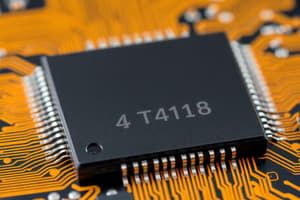Podcast
Questions and Answers
What is defined as a detectable physical quantity or impulse used for transmitting information?
What is defined as a detectable physical quantity or impulse used for transmitting information?
- Noise
- Frequency
- Signal (correct)
- Waveform
What major advantage does using mixed signal products provide for sensor design in embedded systems?
What major advantage does using mixed signal products provide for sensor design in embedded systems?
- It simplifies the design by integrating amplifiers and filters. (correct)
- It eliminates the need for analog sensors entirely.
- It allows for an unlimited number of sensors.
- It requires no programming knowledge.
In the context of signal processing, a signal can be described as a function that conveys what?
In the context of signal processing, a signal can be described as a function that conveys what?
- Electromagnetic interference.
- Information about a phenomenon. (correct)
- Static voltage levels.
- Random noise patterns.
How were analog sensors traditionally interfaced before the introduction of mixed signal controllers?
How were analog sensors traditionally interfaced before the introduction of mixed signal controllers?
According to the definition provided, what is NOT a characteristic of a signal?
According to the definition provided, what is NOT a characteristic of a signal?
What characteristic defines a continuous time signal?
What characteristic defines a continuous time signal?
Which type of signal has uncertainty in its value at some instants of time?
Which type of signal has uncertainty in its value at some instants of time?
How is an even signal mathematically defined?
How is an even signal mathematically defined?
Which of the following signals is an example of an odd function?
Which of the following signals is an example of an odd function?
What unit is used to measure Voltage?
What unit is used to measure Voltage?
What distinguishes deterministic signals from non-deterministic signals?
What distinguishes deterministic signals from non-deterministic signals?
Which units are not traditionally associated with measuring physical quantities?
Which units are not traditionally associated with measuring physical quantities?
Which of the following classifications of signals does NOT include temporal attributes?
Which of the following classifications of signals does NOT include temporal attributes?
What condition must a signal satisfy to be classified as periodic?
What condition must a signal satisfy to be classified as periodic?
Which of the following describes an energy signal?
Which of the following describes an energy signal?
Which of the following is true regarding power signals?
Which of the following is true regarding power signals?
What qualifies a signal as being real?
What qualifies a signal as being real?
What type of signal is represented by x(t) = 3j?
What type of signal is represented by x(t) = 3j?
Which of the following devices is classified as a mixed-signal circuit?
Which of the following devices is classified as a mixed-signal circuit?
What is the main purpose of a sensor?
What is the main purpose of a sensor?
Which statement about energy and power signals is true?
Which statement about energy and power signals is true?
What property does a Temperature Sensor primarily measure?
What property does a Temperature Sensor primarily measure?
Which type of sensor detects the presence of an object without physical contact?
Which type of sensor detects the presence of an object without physical contact?
What type of sensor utilizes sound waves to measure distance?
What type of sensor utilizes sound waves to measure distance?
In which application are IR Sensors most commonly used?
In which application are IR Sensors most commonly used?
Which sensor is suitable for detecting smoke and triggering an alarm?
Which sensor is suitable for detecting smoke and triggering an alarm?
What type of project could utilize a Humidity Sensor?
What type of project could utilize a Humidity Sensor?
What is one application of a Proximity Sensor?
What is one application of a Proximity Sensor?
Which sensor would you use to measure light intensity?
Which sensor would you use to measure light intensity?
Flashcards are hidden until you start studying
Study Notes
Introduction to Mixed Signal and Sensors
- Mixed signal controllers integrate amplifiers and filters directly with microcontrollers, simplifying sensor interface design.
- This integration reduces complexity and design time in embedded systems.
Signal Fundamentals
- Signals are functions conveying information, typically in the form of electrical or electromagnetic currents.
- Key characteristics of signals:
- Detectable physical quantity
- Measurable
- Contains information
- All signals are inherently analog
Units of Measurement
- Common units include:
- Temperature: °C
- Pressure: Newtons/m²
- Mass: kg
- Voltage: Volts
- Current: Amps
- Power: Watts
Signal Classification
-
Continuous Time and Discrete Time Signals:
- Continuous: Defined at all time instants.
- Discrete: Defined at distinct time points.
-
Deterministic and Non-deterministic Signals:
- Deterministic: Exact values definable by mathematical formulas.
- Non-deterministic: Random values with uncertainty; modeled probabilistically.
-
Even and Odd Signals:
- Even: Satisfies x(t) = x(-t); e.g., t².
- Odd: Satisfies x(t) = -x(-t); e.g., sin(t).
- Any function can be expressed as a sum of even and odd components.
-
Periodic and Aperiodic Signals:
- Periodic: Repeats at regular intervals, defined by fundamental period T.
- Aperiodic: Does not repeat regularly.
-
Energy and Power Signals:
- Energy Signal: Has finite energy but zero power.
- Power Signal: Has finite power but infinite energy.
-
Real and Imaginary Signals:
- Real: x(t) = x*(t); has a zero imaginary part.
- Imaginary: x(t) = -x*(t); has a zero real part.
Mixed-Signal Circuits
- Mixed-signal circuits combine properties of both analog and digital circuits.
- Common examples: Comparators, Timers, Phase-Locked Loops (PLLs), ADCs, and DACs.
Introduction to Sensors
- Sensors detect and respond to physical parameters, converting them into measurable electrical signals.
- Sensors are modules or subsystems that interact with the environment and send data to processors.
Types of Sensors
- Common sensor types include:
- Temperature Sensor: Measures changes in temperature via resistance or voltage.
- Proximity Sensor: Detects object presence without physical contact, using methods like optical or ultrasonic.
- Infrared Sensor: Detects light and is widely used in proximity applications, e.g., mobile phones.
- Ultrasonic Sensor: Measures distance and velocity using sound waves above human audible range.
Example Projects
- Light Sensor: Light Detector using LDR.
- Smoke Sensor: Smoke Detector Alarm Circuit.
- Alcohol Sensor: Alcohol Breathalyzer Circuit.
- Touch Sensor: Touch Dimmer Switch with Arduino.
- Color Sensor: Arduino-Based Color Detector.
- Humidity Sensor: DHT11 Humidity Sensor on Arduino.
- Tilt Sensor: How to make a Tilt Sensor with Arduino.
Studying That Suits You
Use AI to generate personalized quizzes and flashcards to suit your learning preferences.




